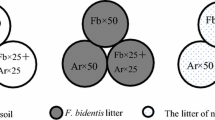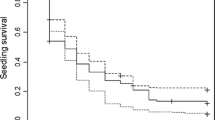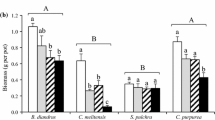Abstract
The invasive grass Microstegium vimineum is widely distributed in closed-canopy forests, but often is patchily distributed under uniform canopy conditions. We hypothesized that the occurrence of patches of invasion may be related to two interacting factors, the presence of dense understory shrub layers and the presence of thick litter layers on the forest floor. Seeds of M. vimineum were sown in plots located under or distant from Lindera benzoin (spicebush) shrubs, and with or without litter manipulations (none, half of natural amount, naturally occurring amount, double the natural amount) in a mature forest in central New Jersey, USA. Populations were monitored for germination and survivorship, as well as growth and fecundity of surviving plants. Neither shrub-associated shade nor litter depth affected seed germination, but both factors affected survivorship, growth and reproduction. The presence of shade from the shrubs reduced survivorship and seed set. Seeds germinating on top of the litter layer also experience higher mortality than seeds germinating under litter and in contact with soil. These results suggest that the interacting effects of shade from understory strata and deep litter layers may limit the spread of M. vimineum. The loss of shrub layers due to intense deer browse and other factors may thus accelerate the spread of this highly invasive species.



Similar content being viewed by others
References
Barbier S, Gosselin F, Balandier P (2008) Influence of tree species on understory vegetation diversity and mechanisms involved—a critical review for temperate and boreal forests. For Ecol Manag 254:1–15
Barden LE (1987) Invasion of Microstegium vimineum (Poaceae) an exotic, annual, shade-tolerant C4 grass, into a North Carolina floodplain. Am Midl Natur 118:40–45
Bohlen PJ, Sheu S, Hale CM, McLean MA, Migge S, Groffman PM, Parkinson D (2004) Non-native invasive earthworms as agents of change in northern temperature forests. Front Ecol Environ 2:427–435
Britton-Simmons K (2006) Functional group diversity, resource preemption, and the genesis of invasion resistance in a community of marine algae. Oikos 113:395–401
Chen W-L, Phillips SM (2006) Flora of China, vol 22. Available at http://www.efloras.org. Missouri Botanical Garden, St. Louis, MO and Harvard University Herbaria, Cambridge, MA
Cheplick GP (2005) Biomass partitioning and reproductive allocation in the invasive, cleistogamous grass Microstegium vimineum: influence of the light environment. J Torrey Bot Soc 132:214–224
Claridge K, Franklin SB (2002) Compensation and plasticity in an invasive plant species. Biol Invasions 4:339–447
Cole PG, Weltzin JF (2004) Environmental correlates of the distribution and abundance of Microstegium vimineum in east Tennessee. Southeast Natur 3:545–562
Cole PG, Weltzin JF (2005) Light limitation creates patchy distribution of an invasive grass in eastern deciduous forests. Biol Invasions 7:477–488
Cook G, Vermeule C (1889) Final report of the state geologist. New Jersey Geological Survey. State of New Jersey, Trenton
Davis M, Grime JP, Thompson K (2000) Fluctuating resources in plant communities: a general theory of invasibility. J Ecol 88:528–534
Davis MA, Thompson K, Grime JP (2005) Invasibility: the local mechanism driving community assembly and species diversity. Ecogra 28:696–704
DeStefano S, DeGraaf RM (2003) Exploring the ecology of suburban wildlife. Front Ecol Environ 1:95–101
Dighton J, Bonilla ASM, Jiminez-Nunez RA, Martinez N (2000) Determinants of leaf litter patchiness in mixed species New Jersey pine barrens forest and its possible influence on soil and soil biota. Biol Fertil Soils 31:288–293
Donath TW, Eckstein RL (2008) Grass and oak litter exert different effects on seedling emergence of herbaceous perennials from grasslands and woodlands. J Ecol 96:272–280
Ehrenfeld JG, Zhu W, Parsons WFJ (1995) Above- and below-ground characteristics of persistent forest openings in the New Jersey Pinelands. J Torrey Bot Soc 122:298–305
Eschtruth AK, Battles JJ (2009a) Acceleration of exotic plant invasion in a forested ecosystem by a generalist herbivore. Cons Biol 23:388–399
Eschtruth AK, Battles JJ (2009b) Assessing the relative importance of disturbance, herbivory, diversity, and propagule pressure in exotic plant invasion. Ecol Monogr 79:265–280
Facelli JM, Pickett STA (1991) Plant litter: dynamics and effects on plant community structure. Bot Rev 57:1–32
Fairbrothers DE, Gray JR (1972) Microstegium vimineum (Trin.) A. Camus (Gramineae) in the United States. Bull Torrey Bot Soc 99:97–100
Fenton A, Pedersen AB (2005) Community epidemiology framework for classifying disease threats. Emerg Infect Dis 11:1815–1821
Flory SL, Clay K (2009) Invasive plant removal method determines native plant community responses. J Appl Ecol 46:434–442
Flory SL, Rudgers JA, Clay K (2007) Experimental light treatments affect invasion success and the impact of Microstegium vimineum on the resident community. Nat Areas J 27:124–132
Fridley JD (2007) The invasion paradox: reconciling pattern and process in species invasions. Ecol 88:3–17
Gibson DJ, Spyreas G, Benedict J (2002) Life history of Microstegium vimineum (Poaceae) an invasive grass in Illinois. J Torrey Bot Soc 129:207–219
Gilbert B, Lechowicz MJ (2005) Invasibility and abiotic gradients: the positive correlation between native and exotic plant diversity. Ecol 86:1848–1855
Griggs JA, Rock JH, Webster CR, Jenkins MA (2006) Vegetative legacy of a protected deer herd in Cades Cove, Great Smoky Mountains National Park. Nat Areas J 26:126–136
Halaj J, Ross DW, Moldenke AR (2000) Importance of habitat structure to the arthropod food-web in Douglas-fir canopies. Oikos 909:139–152
Hale CM, Frelich LE, Reich PB (2005) Exotic European earthworm invasion dynamics in northern hardwood forests of Minnesota, USA. Ecol Appl 15:848–860
Hill SJ, Tung PJ, Leishman MR (2005) Relationships between anthropogenic disturbance, soil properties, and plant invasion in endangered Cumberland Plain woodland, Australia. Austral Ecol 30:775–788
Horton JL, Neufeld HS (1998) Photosynthetic responses of Microstegium vimineum (Trin.) A. Camus, a shade-tolerant, C4 Grass, to variable light environments. Oecol 114:11–19
Hunt DM, Zaremba RE (1992) The northeastward spread of Microstegium vimineum (Poaceae) into New York and adjacent states. Rhodora 94:167–170
Jongejans E, Skarpaas O, Tipping P, Shea K (2007) Establishment and spread of founding populations of an invasive thistle: the role of competition and seed limitation. Biol Invasions 9:317–325
Judge C (2006) Japanese stiltgrass (Microstegium vimineum): population dynamics and management for restoration of native plant communities. Dissertation. North Carolina State University
Judge CA, Neal JC, Derr JF (2005) Response of Japanese stiltgrass (Microstegium vimineum) to application timing, rate, and frequency of postemergence herbicides. Weed Tech 19:912–917
Kellogg CH, Bridgham SD (2004) Disturbance, herbivory, and propagules dispersal control dominance of an invasive grass. Biol Invasions 6:319–329
Kostel-Hughes F, Young TP, Wehr JD (2005) Effects of leaf litter depth on the emergence and seedling growth of deciduous forest tree species in relation to seed size. J Torrey Bot Soc 132:50–61
Kota N, Landenberger R, McGraw J (2007) Germination and early growth of Ailanthus and tulip poplar in three levels of forest disturbance. Biol Invasions 9:197–211
Koval JH, Mertig AG (2004) Attitudes of the Michigan public and wildlife agency personnel toward lethal wildlife management. Wildl Soc Bull 32:232–243
Levine JM, Vila M, D’Antonio CM, Dukes JS, Grigulis K, Lavorel S (2003) Mechanisms underlying the impacts of exotic plant invasions. Proc R Soc: Series B (Biol Sci) 270:775–781
Luken JO, Spath J (2002) Comparison of riparian forests within and beyond the boundaries of land between the lakes National Recreation Area, Kentucky, USA. Nat Areas J 22:283–289
MacDougall AS, Turkington R (2005) Are invasive species the drivers or passengers of change in degraded ecosystems? Ecol 86:42–55
Marshall JM, Buckley DS (2008) Influence of litter removal and mineral soil disturbance on the spread of an invasive grass in a Central Hardwood forest. Biol Invasions 10:531–538
Mau-Crimmins TM, Schussman HR, Geiger EL (2006) Can the invaded range of a species be predicted sufficiently using only native-range data? Lehmann lovegrass (Eragrostis lehmanniana) in the southwestern United States. Ecol Model 193:736–746
Miller JH (2003) Nonnative invasive plants of southern forests: a field guide for identification and control. Gen. Tech. Rep. SRS-62. U.S. Dept. of Agriculture, Forest Service, Southern Research Station, Asheville
Morrison JA, Lubchansky HA, Mauck KE, McCartney KM, Dunn B (2007) Ecological comparison of two co-invasive species in eastern deciduous forests: Alliaria petiolata and Microstegium vimineum. J Torrey Bot Soc 134:1–17
Neumann G, Kohls S, Landsberg E, Souza KSO, Yamada T, Romheld V (2006) Relevance of glyphosate transfer to non-target plants via the rhizosphere. J Plant Dis Prot 20:963–969
Oswalt CM, Oswalt SN (2007) Winter litter disturbance facilitates the spread of the nonnative invasive grass Microstegium vimineum (Trin.) A. Camus. For Ecol Manag 249:199–203
Pokorny ML (2005) Plant functional group diversity as a mechanism for invasion resistance. Restor Ecol 13:448–459
Redman D (1995) Distribution and habitat types for Nepal Microstegium [Microstegium vimineum (Trin.) Camus] in Maryland and the District of Columbia. Castanea 60:270–275
Ricotta C (2005) Through the jungle of biological diversity. Acta Biotheor 53:29–38
Robertson MP, Villet MH, Palmer AR (2004) A fuzzy classification technique for predicting species’ distributions: applications using invasive alien plants and indigenous insects. Divers and Distrib 10:461–474
Rooney TP, Wiegmann SM, Rogers DA, Waller DM (2004) Biotic impoverishment and homogenization in unfragmented forest understory communities. Cons Biol 18:787–798
Rouget M, Richardson DM (2003) Inferring process from pattern in plant invasions: a semimechanistic model incorporating propagule pressure and environmental factors. Amer Natur 162:713–724
Sakai AK, Allendorf FW, Holt JS, Lodge DM, Molofsky J, With KA, Baughman S, Cabin RJ, Cohen JE, Ellstrand NC, McCauley DE, O’Neil P, Parker IM, Thompson JN, Weller SG (2001) The population biology of invasive species. Annu Rev Ecol Syst 32:305–332
Scholz H, Byfield AJ (2000) Three grasses new to Turkey. Turk J Bot 24:263–267
Schwarz D, Matta BM, Shakir-Botteri NL, McPheron BA (2005) Host shift to an invasive plant triggers rapid animal hybrid speciation. Nat 436:546–549
Stohlgren TJ (2006) Scale and plant invasions: a theory of biotic acceptance. Preslia 78:405–426
Stohlgren TJ, Binkley D, Chong GW, Kalkhan MA, Schell LD, Bull KA, Otsuki Y, Newman G, Bashkin M, Son Y (1999) Exotic plant species invade hot spots of native plant diversity. Ecol Monogr 69:25–46
Swearingen JM, Adams S (2008) WeedUS: database of plants invading natural areas in the United States of America. Plant Conservation Alliance, Alien Plant Working Group Weeds Gone Wild. http://www.nps.gov/plants/alien/list/a.htm
Tews J, Brose U, Grimm V, Tielborge K, Wichmann MC, Schwager M, Jeltsch F (2004) Animal species diversity driven by habitat heterogeneity/diversity: the importance of keystone structures. J Biogeogr 31:79–92
Thuiller W, Richardson DM, Pysek P, Midgley GF, Hughes GO, Rouget M (2005) Niche-based modelling as a tool for predicting the risk of alien plant invasions at a global scale. Glob Change Biol 11:2234–2250
Von Holle B, Simberloff D (2004) Testing Fox’s assembly rule: does plant invasion depend on recipient community structure? Oikos 105:551–563
Von Holle B, Simberloff D (2005) Ecological resistance to biological invasion overwhelmed by propagule pressure. Ecol 86:3212–3218
Winterer J, Walsh MC, Poddar M, Brennan JW, Primak SM (2005) Spatial and temporal segregation of juvenile and mature garlic mustard plants (Alliaria petiolata) in a central Pennsylvania woodland. Amer Midl Natur 153:209–216
Xu S, Leri AC, Myeni SCB, Jaffe PR (2004) Uptake of bromide by two wetland plants (Typha latifolia L. and Phragmites australis (Cav.) Trin. ex Steud). Environ Sci Tech 38:5642–5648
Acknowledgments
The work of two anonymous reviewers greatly improved this manuscript, and their contributions are gratefully acknowledged. This research was also facilitated in part by funding from the Garden Club of America (Caroline Thorn Kissel Scholarship) and the New England Botanical Club (Graduate Student Research Award).
Author information
Authors and Affiliations
Corresponding author
Appendix
Appendix
See Fig. 4.
A map detailing the design and layout of the experimental plots in three blocks (A, B, C). Each block contained 15 plots, and each plot was randomly assigned one of five litter treatments (a, b, c, d, e). Each plot was further split into two 100-cm2 subplots, one with shrub shade (s) and one without (n). Total distance between blocks A and C was approximately 250 m, and the slope and aspect in all three blocks was approximately equal
Rights and permissions
About this article
Cite this article
Schramm, J.W., Ehrenfeld, J.G. Leaf litter and understory canopy shade limit the establishment, growth and reproduction of Microstegium vimineum . Biol Invasions 12, 3195–3204 (2010). https://doi.org/10.1007/s10530-010-9711-1
Received:
Accepted:
Published:
Issue Date:
DOI: https://doi.org/10.1007/s10530-010-9711-1





